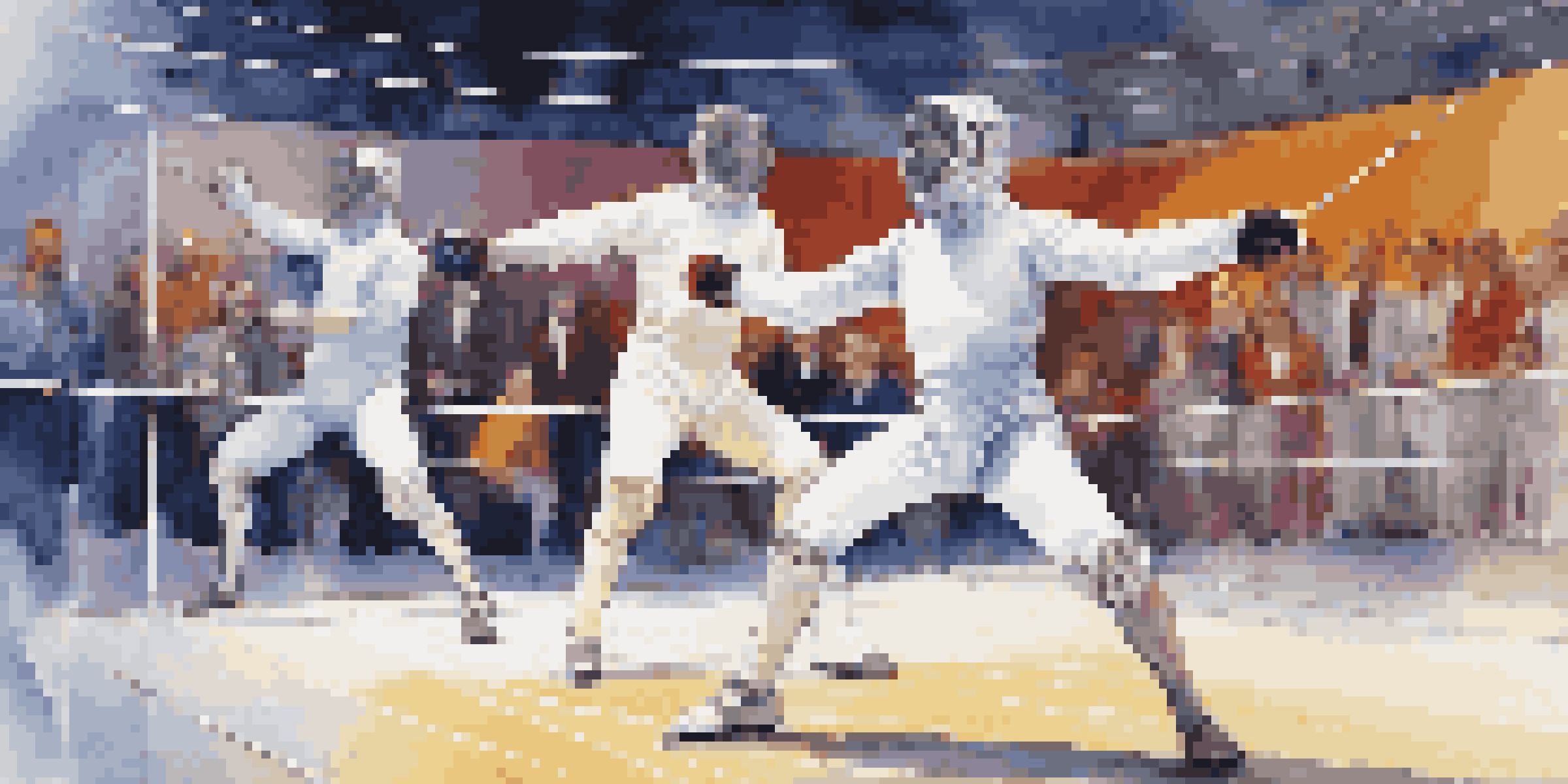The Impact of Technology in Fencing: Modernizing the Sport

Introduction to Technology in Fencing
Technology has woven itself into the fabric of many sports, and fencing is no exception. From the inception of electronic scoring systems to advanced training tools, technology is reshaping how the sport is practiced and experienced. This integration not only enhances performance but also enriches the spectator experience, making fencing more accessible and exciting.
Technology is best when it brings people together.
Consider the traditional days of fencing, where judges relied solely on their observations to score a match. Today, electronic scoring devices ensure accurate, immediate results, reducing the chances of human error. This shift not only promotes fairness but also elevates the sport's professionalism, attracting new fans and participants alike.
As we dive deeper into the various technological advancements, we’ll uncover how each innovation contributes to modernizing fencing, making it a sport that honors tradition while embracing the future.
Electronic Scoring Systems in Fencing
One of the most significant advancements in fencing is the introduction of electronic scoring systems. These systems accurately track touches using sensors in the weapons and scoring gear, which registers hits in real time. This accuracy ensures that matches are scored fairly and efficiently, creating a more engaging experience for both fencers and spectators.

Imagine a match where every touch is counted flawlessly, eliminating the tension and controversy that often arises from human judgment. This technology not only improves fairness but also allows coaches and fencers to analyze performance with precision. Instant feedback can lead to quicker adjustments during training and competitions.
Tech Enhances Fencing Fairness
The introduction of electronic scoring systems and video review technology has improved the accuracy and integrity of fencing competitions.
Overall, electronic scoring has transformed fencing into a more dynamic and transparent sport, where fans can enjoy the thrill of the action without the cloud of uncertainty surrounding the scores.
Video Review Technology Enhancements
In addition to electronic scoring, video review technology has made its mark on the sport of fencing. Much like in other sports, this technology allows for the review of critical moments in a match, giving referees the ability to overturn or confirm decisions. This not only elevates the standard of officiating but also builds trust with athletes and fans.
Innovation distinguishes between a leader and a follower.
Imagine the tension of a close match decided by a controversial call. Video review can clarify those moments, ensuring that the right athlete is awarded victory. This added layer of scrutiny helps uphold the integrity of the sport, making it more appealing to viewers who appreciate fair play.
As video technology continues to evolve, it offers even more potential for enhancing the sport, encouraging fencers to push their limits while knowing that fairness is prioritized.
Training Innovations: Virtual Reality and More
Training in fencing has also been revolutionized by technology, particularly through the use of virtual reality (VR) systems. These immersive environments allow fencers to practice their techniques and strategies without the need for a physical partner. This flexibility can enhance muscle memory and improve reaction times in a controlled setting.
For instance, a fencer can don a VR headset and face a digital opponent, simulating various scenarios. This not only makes training more engaging but also prepares athletes for the unpredictability of live matches. With the ability to review sessions, fencers can identify areas for improvement and track their progress over time.
Innovative Training Tools Emerge
Virtual reality and wearable technology are transforming fencing training, allowing athletes to enhance skills and track performance effectively.
Ultimately, these training innovations contribute to a more skilled and confident generation of fencers, ready to compete at higher levels.
Wearable Technology for Performance Tracking
Wearable technology is another exciting frontier in fencing, providing athletes with valuable insights into their performance. Devices such as smartwatches and fitness trackers can monitor heart rates, movement patterns, and even stress levels during training and competitions. This data empowers fencers to tailor their training regimens to optimize performance.
Imagine a fencer receiving real-time feedback on their physical exertion or technique adjustments right on their wrist. This allows for immediate modifications to enhance effectiveness and reduce the risk of injury. The ability to track progress over time also fosters a sense of accountability and motivation.
As wearable technology continues to advance, it holds the promise of redefining how fencers approach their training and competition, paving the way for peak performance.
Social Media and Fencing Community Engagement
Technology has also transformed how fencers connect with one another and engage with the sport through social media. Platforms like Instagram, Twitter, and TikTok have become vital spaces for sharing techniques, successes, and community stories. This connectivity helps foster a vibrant fencing community that thrives on collaboration and support.
Consider how a fencer can share their training journey, inspire others, and receive feedback from fellow enthusiasts worldwide. This not only encourages personal growth but also helps raise awareness of the sport, drawing in newcomers who may not have previously considered fencing as a hobby or career.
Social Media Connects Fencers
Platforms like Instagram and TikTok are fostering a vibrant fencing community, enabling athletes to share experiences and engage with one another globally.
In essence, social media has become a powerful tool for building a strong fencing community, empowering athletes and fans alike.
The Role of Technology in Competitions
Technology plays a pivotal role in enhancing the overall experience of fencing competitions. Beyond electronic scoring and video reviews, advancements in broadcasting and streaming services have made fencing more accessible to fans around the globe. Now, spectators can watch live matches from the comfort of their homes, opening the sport to a much wider audience.
Imagine a young fencer in a small town watching their idol compete on an international stage via live stream. This accessibility not only inspires future generations but also helps create a sense of global camaraderie among fencing enthusiasts. The sport’s reach has expanded significantly, creating opportunities for sponsorships and support.

As technology continues to evolve, the potential for engaging audiences and showcasing the sport remains limitless.
Conclusion: Embracing Change in Fencing
The impact of technology on fencing is undeniable, modernizing the way the sport is practiced, viewed, and experienced. From electronic scoring to social media engagement, these advancements create a more dynamic, fair, and connected sport. As fencers and fans alike embrace these changes, the future of fencing looks bright.
While tradition remains important, the willingness to adapt and innovate is crucial for the sport’s growth and longevity. By welcoming technology, fencing can attract new participants and retain the interest of seasoned athletes, ensuring its continued relevance in a fast-paced world.
In conclusion, the integration of technology in fencing exemplifies how innovation can enhance even the most time-honored sports, making them more exciting and accessible for everyone involved.